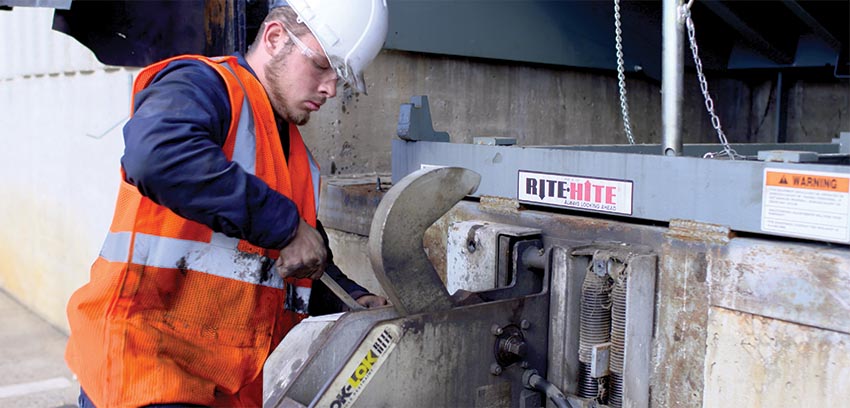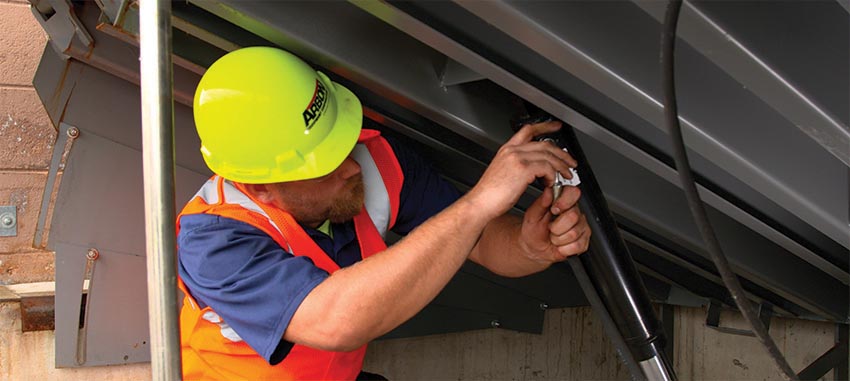The Essentials of Dock Maintenance
Overlook the condition of your docks, and you will pay a price. But it doesn’t have to be that way. It can be as straightforward as inspect, clean, lubricate, adjust and document—and you can save as much as 18% in maintenance costs.
Dock maintenance is easy to overlook. After all, the point of docks, whether you have two or 100, is to receive goods and ship goods without interruption. And that last word is right where the importance of dock maintenance becomes painfully visible.
“Everyone is aware of the need for dock maintenance,” says Rich Schlesinger, manager of U.S. distribution sales at Entrematic, which supplies Kelley and Serco dock equipment.
But as he points out, maintenance may take a back seat to moving goods daily. After all, the typical dock accommodates 100,000 crossings a year.
“When docks are down, they will cost you money,” says Trip Boland, district sales manager at Arbon, the wholly owned service and installation arm of Rite-Hite. Improper maintenance causes 70% to 85% of all equipment failures, he adds. And there’s more to gain with a planned maintenance program than just eliminating as many emergency renewal/repair costs as possible.
Boland says these programs cut maintenance costs 12% to 18%. Energy bills can also be trimmed between 5% and 20%. And planned maintenance, at the least, minimizes if not eliminates bottlenecks caused by docks that are unexpectedly unusable.
There is also the issue of workers’ compensation resulting from injuries caused by poorly maintained equipment. Workers’ comp costs often have a direct impact on the company’s bottom line.
In addition, says Schlesinger, regular maintenance extends the lift of dock equipment, translating into a better return on investment. It also extends the time between capital expenditures and equipment installation disruption at the dock.
Both Boland and Schlesinger point out that planned maintenance does not completely eliminate the need for reactive maintenance. But these programs do cut down reactive maintenance to 20% or less of the work required to keep docks up and running.
Getting started
“Understanding the importance of maintenance and actually having an active maintenance program are two different things,” says Boland.
About half of both companies’ clients have bought into the planned maintenance approach.
There are multiple approaches here. Companies can either manage maintenance with in-house staff or outsource. Both are effective strategies and can be tailored to the company’s particular operating preference.
In-house staff can operate two ways. One is to be a stand-alone operation that relies entirely on its own people and expertise to maintain dock equipment. The other, which is not uncommon, uses supplier expertise to advise and support the in-house team.
Both suppliers also offer structured maintenance programs featuring their factory-trained experts. This outsource approach relies on the expertise of these technicians with equipment specifically from the supplier.
Many of these outsourced resources visit a location and monitor equipment every 90 days. Others are embedded with the company and are often indistinguishable from company employees. This arrangement allows maintenance people to follow a prescribed maintenance cycle, moving through the facility to a schedule. They are also available on-site for that 20% of reactive maintenance needs, reducing reaction and downtime.
Even operations that run 24/7 can be accommodated. Schlesinger tells the story of such a facility with 100 docks that shuts down one weekend a quarter for general maintenance. That’s when the outsourced team visits and conducts its dock maintenance inspection.
It’s worth noting that the 90-day routine is the recommended rule of thumb. Other options include semi-annual and annual cycles. And even within a 90-day program, different types of equipment require different levels of attention at different frequencies.
For instance, mechanical, hydraulic and electrical components should be examined every 90 days. Head pads and dock seals require less frequent attention. And some equipment, like vehicle restraints, is doing its own monitoring all the time with the help of programmable controller diagnostic capabilities.

The inspection step is a good time to check for poor fits and seals that might be an energy liability.
The whole point, says Boland, is “to catch small things early so they don’t become big and cause problems down the road.”
Following a process
Programs generally break down into five points:
- inspect/monitor,
- clean,
- lubricate,
- adjust, and
- document.
Everything really does start with the inspect/monitor step. To Boland’s comment about not letting little problems become big ones, inspection/monitoring is the first defense with big potential operational and cost benefits.
For instance, the springs in a mechanical dock leveler may not be adjusted properly. As a result, the lift will not pop out as it should and won’t lie down in the trailer properly. If this condition goes unchecked for a period of time, efficiency will suffer in both the positioning of the leveler and its use. Plus, there’s the potential for endangering workers’ fingers and feet. The end result is an under-performing piece of equipment that suffers from excessive wear and tear, slows operations and is a safety hazard.
Inspection is more than looking for early wear and tear. It’s also a time to check the structural integrity of the equipment. If problems are found, proactive maintenance typically allows advantageous repair scheduling and parts ordering in a non-emergency mode.
The list of items to be inspected can be quite extensive. For instance, a dock leveler checklist includes 15 or more items. These range from welds at the front and rear curb angles to decks and lips for cracks and deformations. The list also includes springs, toe guards and shim condition and security.
The inspection step is also a good time to check for poor fits and seals that might be an energy liability. “When looking at the gaps around dock levelers and overhead doors, a single opening can cost anywhere up to $1,600 to $3,500 annually in energy loss,” says Boland. Multiply that by 20 or more doors and there is the potential for some notable energy cost savings.
An option here is to ask the supplier to conduct an energy audit of the facility as it relates to dock equipment. That starts with a look at the difference between internal and external temperatures throughout the year as well as the tightness of the dock doors and seals. Thermal imaging of dock doors is sometimes part of this process. Schlesinger says an energy audit of a facility with 20 dock doors takes about two hours.
Inspection of hydraulics is also critical, ensuring fluid levels are within recommended ranges for efficient operation of the equipment.

Inspection of hydraulics is also critical, ensuring fluid levels are within recommended ranges for efficient operation of the equipment.
In the end, the inspection/monitoring step gives the supplier and facility manager a point in time to document the state of the equipment and identify what is needed to continue its cost-effective and efficient operation going forward.
Cleaning may sound fairly mundane, but it can have a big impact. Typically, technicians thoroughly clean all equipment and components. This includes removing debris from pits, around doors and other key areas. And it’s not just cleaning for cleanliness sake. Debris can obstruct moving parts, limiting their efficiencies. There’s also the matter of safety of the people using the dock equipment.
Lubrication is another aid for efficient operation of the equipment. Not only does it keep working parts in working order, lubrication also protects against corrosion, premature wear and moisture.
Adjusting is where repair, replace or even upgrade come into play. Technicians take what they’ve found so far in the process and make the adjustments that return the equipment to more efficient working order, even if it involves something so small as a tweak.
The entire process finishes off with documentation. Some call this the most important part of the program. It creates a permanent record of what received attention and what was done. Just as important, documentation dates when the work was done, leaving a milestone for future inspections.
It is worth noting that costs of planned maintenance programs depend on several variables. These include the number of docks, condition of the equipment and frequency. Often, an initial inspection is done free of charge.
In the end, proactive dock equipment maintenance programs deliver solid value for their cost, often saving a facility from havoc when it can least accommodate it.
Companies mentioned in this article













